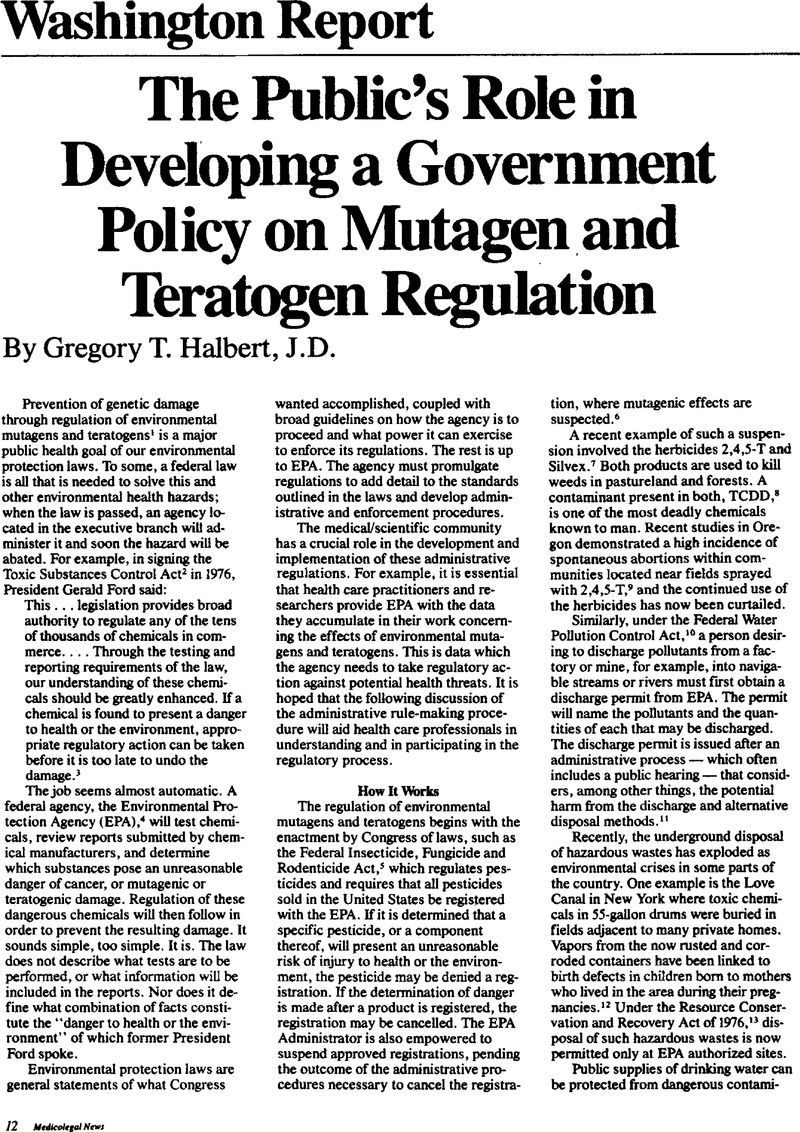No CrossRef data available.
Article contents
The Public's Role in Developing a Government Policy on Mutagen and Teratogen Regulation
Published online by Cambridge University Press: 01 January 2021
Abstract
An abstract is not available for this content so a preview has been provided. Please use the Get access link above for information on how to access this content.

- Type
- Washington Report
- Information
- Copyright
- Copyright © American Society of Law, Medicine and Ethics 1979
References
A “mutagen” is a substance that produces a mutation in reproductive cells and a “teratogen” is a substance that produces a deformity in a fetus. The population at risk to a mutagen includes any person who is capable of becoming a parent. The population at risk to a teratogen is limited to fetuses. Some substances are both mutagens and teratogens.Google Scholar
15 U.S.C. § 2601 et seq.Google Scholar
The Environmental Protection Agency (EPA) is a regulatory agency established by Reorganization Plan Number 3 of 1970. It is charged with the administration and enforcement of environmental protection laws. EPA is headed by an Administrator who is appointed by the President with the advice and consent of the United States Senate. United States Government Organization Manual (1972–73) at 404.Google Scholar
7 U.S.C. &sC: 136 et seq. (effective October 21, 1972).Google Scholar
40 C.F.R. § 162.11(a)(3)(ii)(A).Google Scholar
See Emergency Suspension Order, dated February 28, 1979, and published in 44 Federal Register 15874 (March 15, 1979).Google Scholar
2,3,7,8-tetrachlordibenzo–p–dioxin.Google Scholar
Eight women informed EPA that they lived within 12 miles of Alsea, Oregon where 2,4,5–T and silvex were used in forest management. They experienced a total of 13 spontaneous abortions between 1972 and 1977. Most of the spontaneous abortions occurred eight to ten weeks after conception and four to six weeks after the spring application of 2,4,5,-T in nearby forest areas. This was a rate almost three times greater than that of the control groups that were studied. 44 Federal Register at 15880 (March 15, 1979).Google Scholar
33 U.S.C. § 1251 et seq. The National Pollutant Discharge Elimination Permit Program is established in 33 U.S.C § 1342.Google Scholar
33 U.S.C. § 1342 (a) (I) and implementing regulations 40 C.F.R. § 125.Google Scholar
Preliminary data from a New York State Health Department report shows an increased rate of spontaneous abortions (miscarriages), birth defects, and low birth weights in pregnant women who live in areas surrounding the Love Canal in Niagara Falls, New York. The canal was long–used as a dumping ground for toxic chemicals. Environmental Reporter 9(43):2003–04 (February 23, 1979).Google Scholar
42 U.S.C. § 6901 et seq.Google Scholar
42 U.S.C. § 300(f) et seq.Google Scholar
15 U.S.C. § 2605 (e). PCBs have been detected in human breast milk. An estimated 300 million pounds of PCBs have escaped into the environment. Particularly tainted waters include Chesapeake Bay, the Hudson River, San Francisco Bay, the Gulf of Mexico, the waters of Florida, and Puget Sound.Google Scholar
5 U.S.C. § 551 et seq.Google Scholar
5 U.S.C. § 551 (4).Google Scholar
43 Federal Register 12661, 12662.Google Scholar
44 Federal Register 10270.Google Scholar
44 Federal Register 10270.Google Scholar
42 Federal Register 13579.Google Scholar




